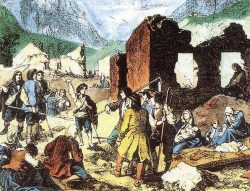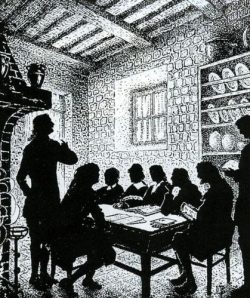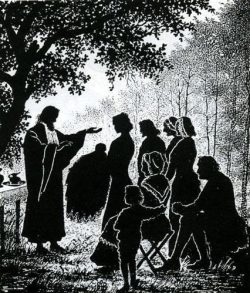The secret re-building
of churches
The secret re-building of churches was the work of Antoine Court who re-established discipline in Reformed Churches, first in the south then in some areas of the north.
The makeshift "Church of the Desert" (1685-1715)
The period of secrecy for the Protestant church is called the “Desert”. The name was invented when secret meetings were held at the instigation of preachers or prophets, with no overall organisation or cooperation. The frequency of these meetings depended on the area, and the congregation number also varied. They were banned, and when discovered were very harshly dealt with : men were sent to the galleys, women to prison and the preachers executed. Most meetings were in Languedoc and the Cevennes. The prophesy phenomenon, started in Dauphiné, reached the Cevennes around 1700 and led to the war of the Camisards.
Recreating an organised church at the Montèzes' synod
The re-building of the Church began in 1715, under the leadership of the young preacher Antoine Court. On 24th August 1715 a meeting of nine people (4 lay and 5 preachers) was held in the hamlet of Montèzes (Gard). This meeting was later given the name Synod of Montèzes because it was decisive for the future of the Reformed Church. The participants tried to regulate “Churches of the Desert” meetings, silence the prophets – especially the women – and replace the “prophetic revelations” with biblical preaching. They condemned rebellion and advocated peaceful meetings that prayed for the king.
The most important step was the restoration of elders according to Reformed Church statutes prior to 1685 These elders would be responsible, taking every care, for organising meetings, finding safe hiding places for preachers, guides to take them there and for making collections for the poor.
Antoine Court presided at this meeting. Among the preachers present were : Jean Huc, preacher, former Camisard in the company of Rolland ; Jean Vesson, a former prophet ; Pierre Durand, brother of Marie Durand.
Little by little this organisation spread to neighbouring areas. Secret local synods, and then national ones, were held fairly regularly during all the “Desert” period, and the minutes of these synods still exist today.
The Church under the Regency (1715 - 1723)
Louis XIV died in 1715. Much Protestant hope rested on the regent, the Duke of Orleans, who came to power. He was well known for his moderate religious ideas and had nothing against the Protestants. But his advisors persuaded him to continue with the policies of Louis XIV and to suppress meetings. However, there was less repression and it varied with time. When the soldiers were on active service or during the plague of 1720, when they didn’t leave their barracks for fear of infection, there was less repression.
It is difficult to estimate how many meetings were held since those known about are only the ones that were discovered. For every meeting discovered probably a hundred went undiscovered. We know that meetings were held in Pays de Foix ; in Poitou and also in Picardy.
The pastors of the Refuge did not understand Antoine Court’s thinking and considered “Church of the Desert” meetings as acts of insurrection against the king. Thus, when Antoine Court called these pastors to return to France, he was not listened to. This is why he dreamt of a training institution for preachers. The Lausanne seminary established in 1726.
Meeting practices in the "Church of the Desert"
Until 1743 meetings were held at night, in isolated places, under the leadership of pastors or preachers. In 1718 there were only three pastors : Pierre Corteiz, a former Camisard who was consecrated pastor in Zurich, Antoine Court who had hands laid on him by Corteiz during a secret synod and Jacques Roger, a pastor trained and consecrated in Germany, who returned to France in 1715 and exercised his ministry in Dauphiné.
During meetings only pastors could celebrate the Lord’s Supper. They also performed baptisms and weddings, but many of the faithful continued to marry and baptise their children in the Catholic Church. The call by pastors to no longer marry or attend mass in the Catholic Church hardly had any effect as witnessed by the all the advice on this subject from every synod of the “Desert” period. To do this was risky for the followers. Since marriage in the “Church of the Desert” had no legal status, children were considered bastards and could not inherit from their parents. From 1745 the practices of the “Church of the Desert” gradually spread and there arose the problem of legal recognition of marriages and the children from them.
After years of intervention on behalf of the king, the Edict of Tolerance (1787) finally gave Protestants legal status.
Bibliography
- Books
- BOST Charles, Les prédicants protestants des Cévennes, Presses du Languedoc, 2002
- BOST Hubert (éd.), Entre Désert et Europe : le pasteur Antoine Court, Actes du Colloque de Nîmes (1995), Champion, Paris, 1998
- CARBONNIER-BURKARD Marianne et CABANEL Patrick, Une histoire des protestants en France, Desclée de Brouwer, Paris, 1998
- HUGUES Edmond, Antoine Court. Histoire de la restauration du protestantisme en France au XVIIIe siècle, M. Lévy, Paris, 1872
Associated tours
-
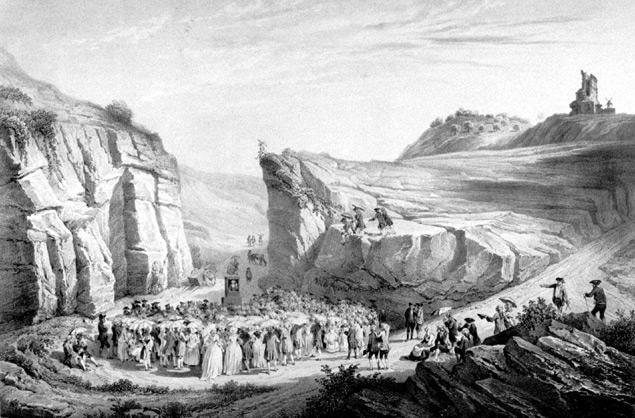
Religion in the “Desert” period
After the Revocation of the Edict of Nantes in 1685, French Protestants went into exile or abjured their religious faith. However, among those who abjured, some continued to practice in...
Associated notes
-
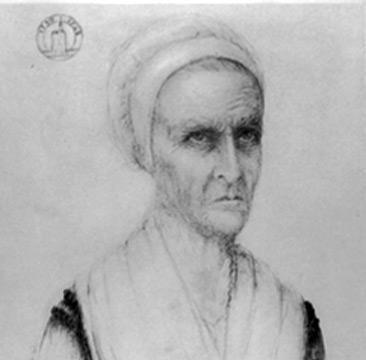
Marie Durand (1711-1776)
For the French protestants, Marie Durand symbolized those who resisted religious intolerance after the revocation of the Edict of Nantes. -
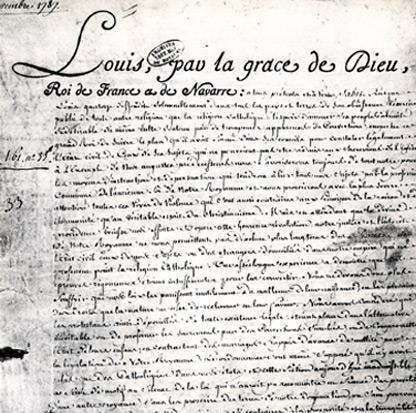
The Edict of Toleration (November 29th, 1787)
With this Edict, King Louis XVI granted the Protestants civil status. He secured their right to live in the kingdom without discrimination for religious reasons. -

The secret meetings
Long before the Revocation of the Edict of Nantes in 1685, freedom of worship for Protestants was already being questioned. Following the Revocation of the Edict of Nantes, three quarters... -
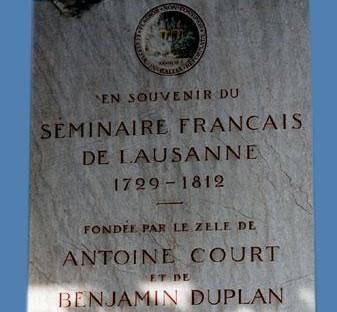
The Lausanne Theological Seminary (1726-1812)
The seminary in Lausanne was started at the instigation of Antoine Court. Its purpose was to train those called to the ministry in France during the “Desert” period. -
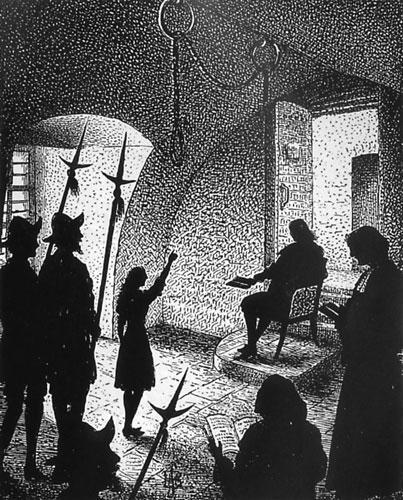
Prophetic Movement
In the years following the Revocation of the Edict of Nantes, a Prophetic Movement, quite alien to the Reformed tradition, stirred up Protestant peasants from the South of France and... -
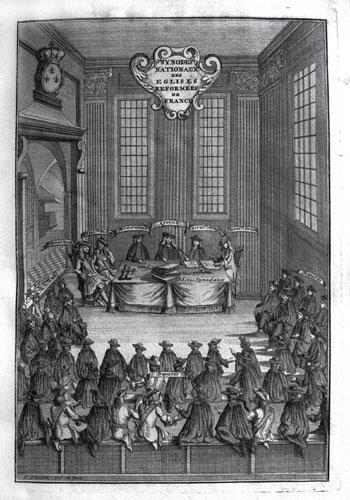
The organisation of the Reformed Church
The Reformed Churches were organised according to the order of 1559, as had been the case in the sixteenth century. They were ruled by a series of bodies at local,... -
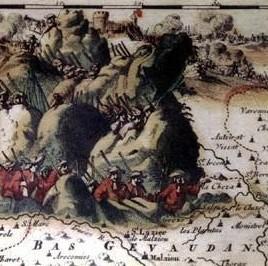
The war of the Camisards (1702-1710)
The « Cévennes war » was the name given in the 18th century to the guerrilla warfare that devastated the Cévennes in the early years of the century and tried to re-establish... -

The sentences imposed on Protestants
The Edict of Fontainebleau (1685) and various decrees of 1686 imposed penalties on Protestants. -

Antoine Court (1695-1760)
Antoine Court gave himself to the restoration and reorganisation of Protestantism in France after the revocation of the Edict of Nantes (1685). -

The "Church of the Desert" in the Heroic Period (1715-1760)
The time when Reformed Church religious practices were banned by royal edicts is called the “Desert” period. They had to be performed in secret. It is called “heroic” because, when...

